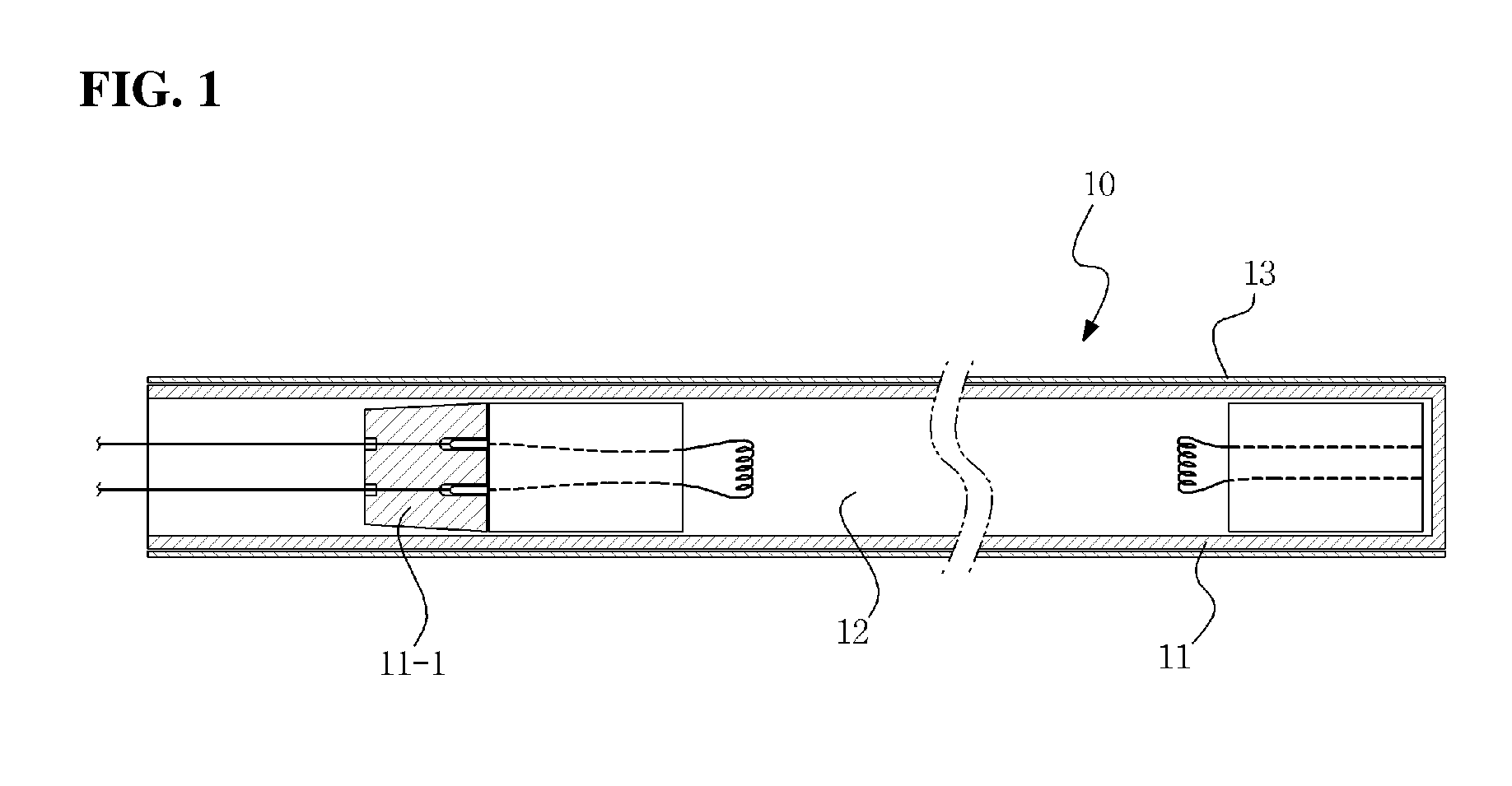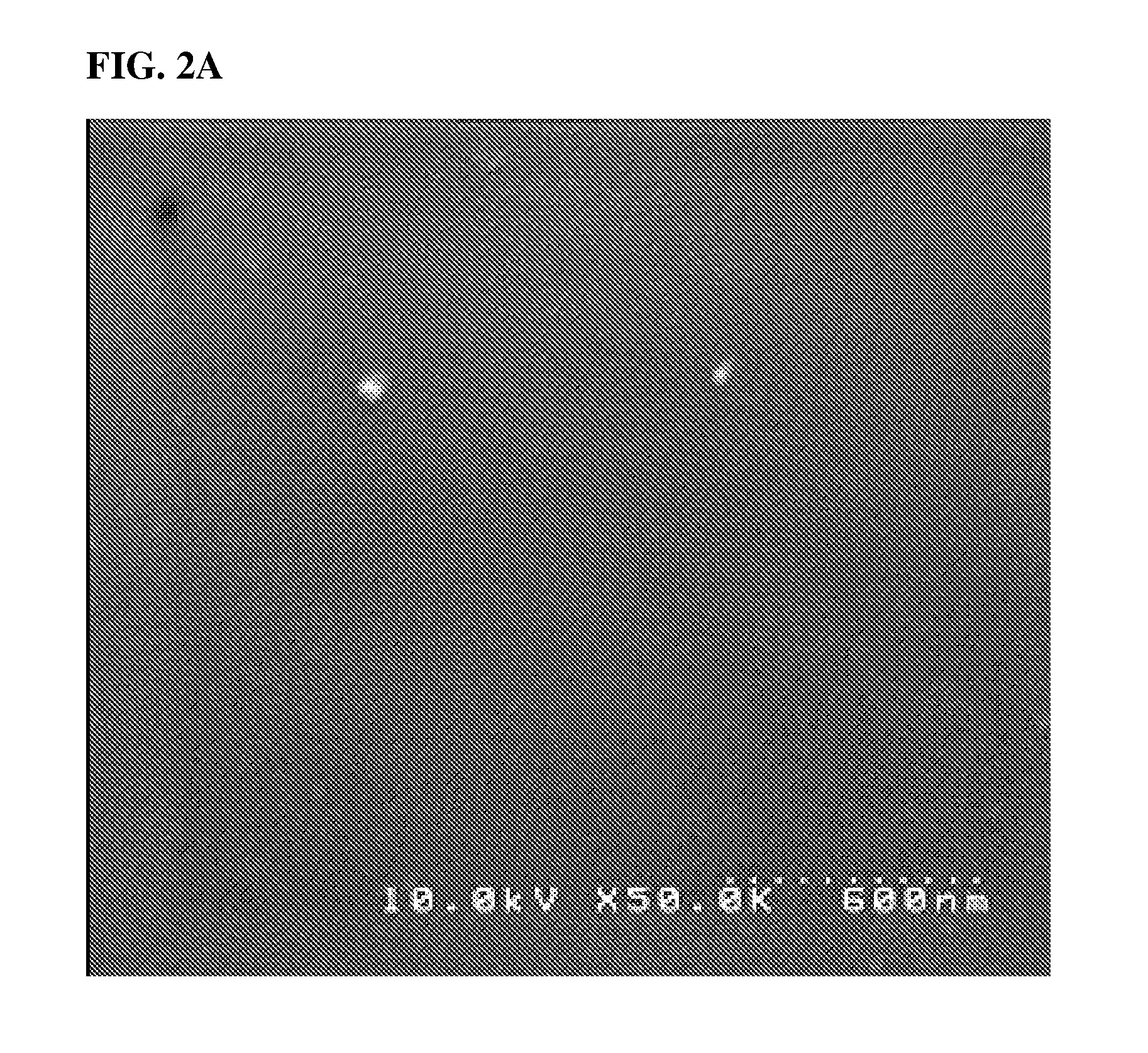Apparatus and method for disinfecting food using photo-catalytic reaction of titanium dioxide and ultraviolet rays
a technology of titanium dioxide and disinfection food, which is applied in the direction of disinfection, chemical/physical/physical-chemical processes, energy-based chemical/physical/physical-chemical processes, etc., can solve the problems of almost no trial application of titanium dioxide photo-catalyst disinfection technique to foods, and the decomposition of organic compounds, so as to improve the function of disinfection food
- Summary
- Abstract
- Description
- Claims
- Application Information
AI Technical Summary
Benefits of technology
Problems solved by technology
Method used
Image
Examples
example 1
Surface of Quartz Tube on Which the Photo-Catalyst Layer of Titanium Dioxide is Formed
[0137]The quartz tube, used in the present invention, having the photo-catalyst layer of titanium dioxide formed on the outer surface thereof was observed with a scanning electron microscopy, compared with the quartz tube on which no photo-catalyst layer of titanium dioxide was formed. The results are represented in FIGS. 2A and 2B.
[0138]It could be noted that the quartz tube, on which no photo-catalyst layer of titanium dioxide was formed, had a smooth surface, as shown in FIG. 2A, while the quartz tube, on which the photo-catalyst layer of titanium dioxide was formed, had a surface on which a thin layer of titanium dioxide was formed, as shown in FIG. 2B. It was confirmed that the titanium dioxide particles had a size of 10 to 60 nm and were fixed with a thickness of 700 to 900 nm.
example 2
Photo-Catalyst Disinfecting Apparatus
[0139]Using the disinfecting apparatus as shown in FIG. 3 among various types of disinfecting apparatuses, five (5) quartz tubes with outer diameter×inner diameter×length of 25×22×900 mm on which the thin layer of titanium dioxide was formed so as to maintain high UV transmittance, were placed inside the cover and five (5) quartz tubes with outer diameter×inner diameter×length of 25×22×1090 mm were placed at the bottom of inside space in the case.
[0140]In addition, the UV lamp being irradiated with an intensity of 250 W / m2 at 254 nm was equipped inside each quartz tube to carry out an experiment about the bactericidal effect of disinfecting apparatus. To prove the superiority of bactericidal effect by the photo-catalyst, a control group was experimented using the quartz tube on which no thin layer of titanium dioxide was formed as a protecting tube of the UV lamp unit under the other conditions same as those of the experimental group.
example 3
Bactericidal Effect of Photo-Catalyst Disinfecting Apparatus Against Bacteria
[0141]Using the disinfecting apparatus according to the present invention, the bactericidal effect was experimented against Escherichia coli (ATCC 25922), Listeria monocytogenes (ATCC 15313), Bacillus cereus (ATCC 11778). Salmonella typhimurium (ATCC 14028), and Bacillus subtilis (ATCC 11774) as representative harmful bacteria problematic in fresh foods.
[0142]Escherichia coli was cultured in a lactose broth (Difco, USA) under 150 rpm shaking incubator at 35° C. for 24 hours, Listeria monocytogenes was cultured in a nutrient broth (Difco, USA) under 200 rpm shaking incubator at 36° C. for 24 hours and Bacillus cereus was cultured in a brain heart infusion (Difco, USA) under 150 rpm shaking incubator at 30° C. for 24 hours, Salmonella typhimurium was cultured in a tryptic soy broth (Difco, USA) under 150 rpm shaking incubator at 35° C. for 24 hours, and Bacillus subtilis was first cultured in a Nutrient Broth...
PUM
| Property | Measurement | Unit |
|---|---|---|
| pH | aaaaa | aaaaa |
| pH | aaaaa | aaaaa |
| pH | aaaaa | aaaaa |
Abstract
Description
Claims
Application Information
 Login to View More
Login to View More - R&D
- Intellectual Property
- Life Sciences
- Materials
- Tech Scout
- Unparalleled Data Quality
- Higher Quality Content
- 60% Fewer Hallucinations
Browse by: Latest US Patents, China's latest patents, Technical Efficacy Thesaurus, Application Domain, Technology Topic, Popular Technical Reports.
© 2025 PatSnap. All rights reserved.Legal|Privacy policy|Modern Slavery Act Transparency Statement|Sitemap|About US| Contact US: help@patsnap.com



